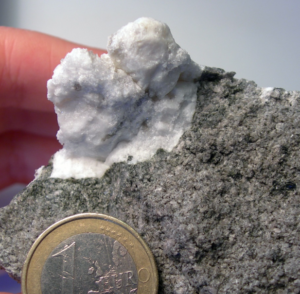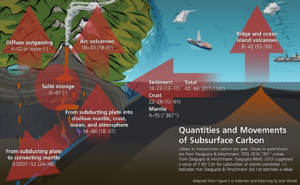
By Frances Deegan and Ralf Halama
Carbon – the element on everyone’s lips. Carbon is unquestionably one of the most important elements on Earth – terrestrial life is carbon-based and so are many of our energy sources. From the perspective of a human time-scale, biological and anthropogenic (caused by human activity) carbon fluxes are very important (e.g. through industrial activity and burning fossil-fuels). However, if we consider time-scales spanning millions of years (the geological time-scale), then Earth degassing becomes an important control on the climate evolution of our planet. Volcanoes are major contributors to long-term Earth degassing and this is what brings us to Indonesia – one of the most volcanically-dense regions on Earth and home to some of the most active and dangerous volcanoes.
Where does volcanic carbon dioxide come from? Indonesia is located above a subduction zone, which is where two tectonic plates meet and one sinks into the Earth’s mantle. This is where crust is destroyed or “recycled” back into the Earth and where arc volcanoes form on the upper plate. The carbon dioxide released from volcanoes in subduction zones comes from a mixture of sources – some comes from the sedimentary rocks that were pushed into the mantle during subduction and some comes from the Earth’s mantle. Scientists have also discovered another source of carbon at subduction zones – the crust sitting on top of the subduction zone, on which the volcanoes are built (the “upper arc crust”).
The limestone-gas connection. Volcanoes located in areas where the bedrock is made of limestone often have an unusually high outflux of carbon dioxide. Could there be a link? Limestone is made of calcium carbonate, CaCO3, and when hot magma reacts with CaCO3 it rapidly breaks down to release large amounts of CO2, contributing to this unusually high outflux of CO2. The exact process during magma-limestone interaction at depth and the timescales over which this can happen have for a long time remained speculative.

Thermally metamorphosed limestone (calc-silicate) fragment entrained in Merapi lava. Source: Frances Deegan.
New research results. At Merapi volcano, a team of scientists from the universities of Keele (UK), Uppsala (Sweden) and Swansea (UK) have found pieces of thermally-altered limestone (calc-silicate xenoliths) among the volcano’s erupted products. They argue that these altered limestone samples record the processes in the underlying magma reservoir and allow them to gain insights into the processes accompanying liberation of CO2 from limestone. New research led by PhD researcher Sean Whitley from Keele University, investigated isotopic ratios of carbon and oxygen in crystals of the mineral calcite in these altered limestone fragments at the Edinburgh Ion-Microprobe Facility. Using these data, scientists can chemically fingerprint the processes that led to formation of calcite in the limestone fragments. Most intriguingly, the team found an unusual carbon isotopic signature that demonstrates highly efficient remobilisation of limestone-derived CO2 into the magmatic system. They further found that this CO2 release occurs over geologically short timescales of hundreds to thousands of years and that during non-eruptive episodes up to half of the CO2 emissions at Merapi derive from the digestion of limestone in the magma storage region, rising to 95% during volcanic eruptions.
Although Merapi is currently considered a relatively minor emitter of CO2 on a global scale, the new results from Sean Whitley and co-workers show that volcanic CO2 liberation can potentially release large amounts of limestone-derived CO2 during eruptive episodes. This increasingly recognised contribution of limestone-derived CO2 to volcanic carbon budgets now requires reconsideration of global carbon cycling models throughout Earth history.
Link to article: Whitley, S., Gertisser, R., Halama, R., Preece, K., Troll, V.R., Deegan, F.M. 2019: Crustal CO2 contribution to subduction zone degassing recorded through calc-silicate xenoliths in arc lavas. Scientific Reports 9:8803, DOI: 10.1038/s41598-019-44929-2.
Do you want to write about your research, or highlight some new research, or just give blogging a go? Then get in touch!


BILL
Very interesting article .Please continue
Perhaps you could expand on the acceleration of co2 release when volcanic heated limestone comes in contact with seawater.
What is the current estimate of under water sea volcanoes ? accuracy ? IYO
Is there an area of ocean floor that is not been routinely monitored for volcanic activity in remote areas?
Mark
This interesting blog post delves into the fascinating miracle of limestone digestion by tinderboxes and its implicit donation to advanced atmospheric carbon dioxide( CO2) situations. The complex interplay between Earth’s geological processes and atmospheric chemistry continues to allure scientists and offers precious perceptivity into our earth’s carbon cycle.
Limestone, a mineral resource of immense significance, is known for its varied operations across diligence. still, its commerce with tinderboxes introduces a lower- known aspect of its actuality. The composition highlights how limestone, when subordinated to violent stormy heat and pressure, undergoes a process known as digestion, releasing carbon dioxide into the atmosphere. While this process occurs naturally, it’s pivotal to consider its counteraccusations in the environment of atmospheric CO2 situations and climate change. Understanding the factors that impact the rates of limestone digestion can contribute to more accurate climate models and prognostications.
In relation to the part of limestone manufactories, these machines play a vital part in processing limestone for colorful operations. Although not directly connected to limestone digestion in tinderboxes, limestone manufactories grease the grinding and refinement of limestone into different flyspeck sizes, enabling its application across diligence. ultramodern grinding technologies, similar as perpendicular comber manufactories or ball manufactories, enhance effectiveness and reduce energy consumption, aligning with sustainable practices. Examining the implicit impact of limestone digestion on atmospheric CO2 situations requires a comprehensive understanding of stormy exertion and the geological processes involved. By studying the factors impacting the digestion process, scientists can further upgrade climate models and advance our knowledge of the Earth’s carbon cycle dynamics.
It’s important to emphasize that stormy exertion represents only one element of the complex carbon cycle, which involves colorful natural and anthropogenic sources and cesspools of CO2. As we address the challenges of climate change, a comprehensive approach encompassing emigrations reduction, carbon insulation, and sustainable practices across sectors remains essential. The disquisition of limestone digestion by tinderboxes sheds light on a witching aspect of our earth’s geology and its implicit counteraccusations for atmospheric CO2 situations. By heightening our understanding of this process and its commerce with the broader carbon cycle, we can advance our knowledge of Earth’s systems and contribute to further informed climate mitigation and adaption strategies.
Robert Hutchins
I found a sandstone coated with about 1/8″ limestone in a brook near Mt. Ascutney.
Rob Hutchins
robertdhutchins@yahoo.com